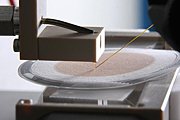- Number 320 |
- September 13, 2010
NanoDESI turns a tiny amount of troublesome aerosols into answers

With nanoDESI, scientists are
breaking the sensitivity limits
of conventional approaches.
Created at DOE’s Pacific Northwest National Laboratory, nanoDESI helps provide detailed answers about chemically complex particles using samples 1,000 times smaller than conventional approaches. nanoDESI, or nanospray Desorption ElectroSpray Ionization technique, provides a reliable, simple way to introduce these samples into a mass spectrometer for detailed analysis of their molecular content.
“NanoDESI reduces the amount of material required for analysis, the time involved, and hence the cost of obtaining data,” said Patrick Roach, a physical chemist at PNNL who invented the nanoDESI approach. “Information from this technique provides insights that could help mitigate the impact of aerosols.”
This work done by Roach, Julia Laskin, and Alexander Laskin was funded by the DOE’s Office of Basic Energy Sciences, Biological and Environmental Research, and the intramural research and development program at EMSL. The nanoDESI is located in EMSL and available to users through EMSL’s proposal process.
[Kristin Manke, 509.372.6011,
kristin.manke@pnl.gov]
